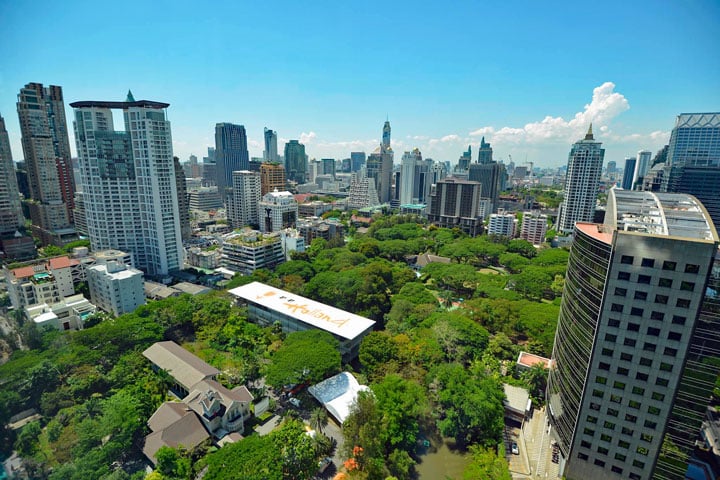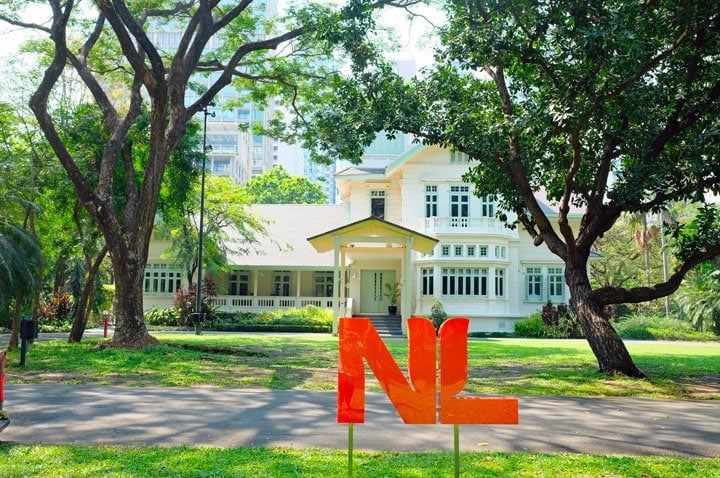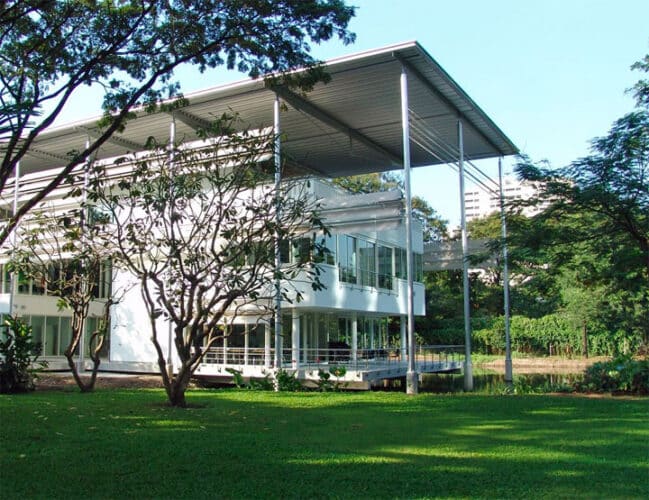The residence of the Dutch ambassador in Thailand

Photo: Facebook Dutch Embassy Bangkok
Amidst Bangkok's imposing urbanism – the glass buildings, the dusty construction sites, the concrete skytrain that cuts through Sukhumvit – Wittayu Road seems a curious exception. A huge stretch of the road is leafy and green, marking the hallowed grounds of historic embassies and residences in Bangkok. Wittayu (Wireless) is named after Thailand's first radio broadcasting station, but it might as well be called Thailand's 'Embassy Row'.
One of these embassies belongs to the Kingdom of the Netherlands. This comes as a surprise to most Thais, as Wittayu's green is most commonly associated with the US Embassy. But since 1949, a piece of land of 2 rai between Wittayu and Soi Tonson has been owned by the Dutch. According to Kees Rade, the ambassador of the Netherlands in Thailand, it is one of the most impressive Dutch embassies in the world.
The garden of the residence
Walking into the lush residence garden feels like stepping into a wonderland. A small moat separates the residence from the embassy building, filled with the same emerald green water – and monitor lizards – supplied by the BMA from neighboring Lumphini Park. Understanding my awe, the guard nearby turns and says, “For first-time visitors, the residence looks like a public park.” The variety of flora and fauna seems to surpass most of Bangkok's public parks, due to a past custom where visitors to the Dutch representation brought trees as gifts.
The residence
The residence itself is a two-story historic villa. Inside, photographs of the Dutch and Thai royal families adorn the walls, alongside paintings by the likes of Karel Appel and Corneille, whose colorful paintings defy the gray aesthetic of WWII European art. A painting of an angel pays homage to the City of Angels.
One of the more unexpected wall ornaments is a long piece of framed snakeskin that spans an entire doorway. Anoma Boonngern, the ambassador's private assistant, explains that the snake was caught and framed inside the property before the Netherlands bought the compound – one of many reptilian creatures that live here. “Who knows, you might find a monitor lizard in the pool!” she jokes “There are so many here” (the ambassador denies ever swimming with them). The moat that surrounds the residence connects to the moat of the US Embassy, giving the reptiles plenty of room to roam.
History
The property itself has a fascinating history and has changed hands a number of times. The land was originally owned by farmers. In the Rattanakosin era, the area that now houses Central World, Siam Paragon and the Royal Bangkok Sports Club was once home to miles of paddy fields intertwined with moat-like khlongs.
It was eventually bought by members of the royal family and some of the first Sino-Thai entrepreneurs, such as Nai Lert. In 1915 the land was owned by King Rama VI. Dr. Alphone Poix, King Rama V's physician, built the great house, which would become the ambassador's original residence.

Prince Bovoradey
Eventually, the royal family handed over the property to the then army chief Prince Bovoradej Kridakara – the same prince who would lead the eponymous Bovoradej uprising. In 1932, while Khana Ratsadon was planning their revolution, Bovoradej tried to sell part of the property to renovate his own villa. He received permission from the king for this, but was unfortunately distracted by other political events, namely the forced transition of Siam to a constitutional monarchy.
Bovoradej was a committed royalist and in 1933 led his own counter-rebellion to save the throne. Phibun Songkhram led the defense of Khana Ratsadon and for two weeks the country was embroiled in a civil war, with bombs falling on Bangkok and fighting in the streets. Eventually, Bovoradej fled into exile abroad, and the property went unclaimed.
Subsequent owners
But the house wouldn't stay empty for long. During World War II, Phibun handed the property over to the Japanese when Thailand officially defected to the Axis powers, and it became one of their army offices. They also used the adjacent estate for the storage of equipment and troops. In the house that would become the residence of the US ambassador in 1947, delicate teak was trampled by army boots and trucks, gun carriages and tanks crushed the surrounding gardens. The two large, old houses were not doing well.
However, the Japanese occupation of the Wittayu residences was short-lived. The Thai movement Seri Thai (Free Thai) kept Thailand on the good side of the Allied Powers.
In March 1949, Prince Boworavej finally sold the property to the government of the Netherlands for the price of 1,85 million ticals (the term foreigners used for the baht). That year, Dutch ambassador Johan Zeeman moved in with a small staff of ten.

The present
Today, the ambassador no longer lives in the villa that Dr. Poix built. “It's fun but not very practical,” admits Ambassador Rade, “especially if you have kids and they run around.” When asked if he is concerned about possible bomb threats against the neighboring US embassy, he laughs. “Luckily bombing embassies is no longer a very prominent issue, partly because of all the measures we have taken to protect ourselves.”
In 2007 a new “Ambassador's Residence” was built. The old residence is still used for receiving guests and holding Ambassadorial dinners (without the interference of young children). The site is used for major embassy events, such as the LGBTI movie night. “LGBTI issues are very close to our hearts,” says the ambassador, “we support NGOs that advocate for better treatment of LGBTI people, and so on.”
The embassy
The embassy itself has grown to a staff of nearly 40. It has undergone several upgrades, such as switching to solar power. But both Anoma and Ambassador Rade have a deep appreciation for the property's history, realizing that the residence is one of a dwindling number of diplomatic historic homes in Bangkok.
“The British embassy and residence used to be the largest of all the representations, but it has now been demolished,” Anoma added with regret. Of the foreign embassies that occupy historic spaces, only a few remain, such as Italy, Portugal, France, America, Belgium, Denmark and the Netherlands.
They are witnesses to Siam and Thailand's long history of international trade, diplomacy and development. Land has always told important stories of power. Wittayu Road's prestigious properties have particularly compelling stories to tell.
Fortunately, the Dutch Representation has carefully preserved this property and has no plans to leave in the near future. In the words of Ambassador Rade, “For someone who has lived in other major cities, the security and development of Bangkok is really something to cherish.”
Source: Thai Enquirer


Good story, Gringo. That way you learn something. I hope that budget cuts are not a reason to sell the site. It must be worth billions of baht. (600.000 baht per square meter in that area).
When I lived in Bangkok, the embassy and residence were in the same building, with a beautiful park from the wireless to it, and a huge garden behind it.
Many festivities were held there together with the Dutch Association, for example, we experienced that Sinterklaas was not allowed to ride a horse through the wireless rd, but apparently he was allowed to ride an elephant, so Sinterklaas and his helpers came to the embassy on an elephant and was that front page news in the Bangkok Post
Easter egg hunt in the garden, with Easter breakfast for everyone, old Dutch games day and much more, beautiful memories of this beautiful location
Been in October 2017 with my 2 granddaughters.
For receiving my father's war memorial medals posthumously.
Who worked here on the bridge as a prisoner, from 03-03-1942 to 15-08-1945.
In the presence of the entire staff, unfortunately I can't post photos here.
We also had lunch there, after the official part.
Beautiful building, both inside and out.
Hans van Mourik
Interesting story!
Quote:
But since 1949, a piece of land of 2 rai between Wittayu and Soi Tonson has been owned by the Dutch.
Of course everyone is now dying to know what Wittayu and Tonson mean. Wittayu วิทยุ (withajoe, three high notes) means 'radio' and Tonson ต้นสน (tonson, descending, rising tone) means 'pine tree'. The last time I was in the embassy, 5 years ago, there were still two rows of pine trees along that soi (street, alley).
dear tina,
I admire the fact that you are so "obsessed" with explaining all those names.
If there were a Dutch blog for Thais, I can not imagine that there is even 1 Thai living in the Netherlands interested in the explanation of names such as 2nd Gasselternijveensschemond, Blauwhuis, Rosmalen, Bergeijk, Nibbixwoud or Tino.
Chris comes from the Greek and means 'Anointed One'. Tino means 'Brave'.
Maybe, Chris, you should do some research before you say something. You have to know Thai for that, of course. Something you can't imagine can actually exist.
There are certainly Thais who are interested in the meaning of Dutch names, although I'm not sure if they live in the Netherlands, probably they do.
https://hmong.in.th/wiki/Dutch_name
For example about the name 'Adelbert':
More information ระบุเพศของบุคคลที่ ชื่ออย่าง Adelbert หรือ Albert ประกอบด้ วย”nobility” (แปลว่า”ผู้ดี” ) และ”bert”ซึ่งมาจาก”beracht” (แปลว่า”สว่ าง”หรือ”ส่องแสง ” ) ดังนั้นชื่อจึงหมายถึงบางสิ่งตามลำดับ” Bright / ส ่องผ่านพฤติกรรมอันสูงส่ง “; Image caption Image caption
of
About us น"Kees" (Cornelis), "Jan" (John)และ"Piet" (Peter) ได้ปรากฏขึ้น